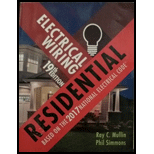
ELECTRICAL WIRING:RESIDENT.-TEXT (PB)
19th Edition
ISBN: 9781337116213
Author: MULLIN
Publisher: CENGAGE L
expand_more
expand_more
format_list_bulleted
Concept explainers
Question
Chapter 15, Problem 1R
To determine
Name the switches, receptacles, and other wiring devices that are connected to Circuit B10.
Expert Solution & Answer
Explanation of Solution
Discussion:
Refer to Figure 15-9 in the textbook, which shows the cable layout for laundry, rear entrance, powder room, and attic (Circuit B10).
Table 1 shows the switches, receptacles, and other wiring devices in Circuit B10 from Figure 15-9 and Table 15-1 in the textbook.
Table 1
| Description | Quantity |
| Laundry exhaust fan | 1 |
| Powder room vanity luminaire | 1 |
| Attic luminaires @75 W each | 4 |
| Rear entry vanity luminaire @ 100 W each | 2 |
| Laundry room fluorescent luminaire four 32 W lamps | 1 |
| Powder room exhaust fan | 1 |
| Switches | |
| Single-pole switches | 4 |
| Single-pole switch with pilot light | 1 |
| Three-way switches | 2 |
| Receptacles | |
| Receptacles-regular | 1 |
| Receptacles-GFCI type | 1 |
Conclusion:
Thus, the switches, receptacles, and other wiring devices that are connected to Circuit B10 are named in Table 1.
Want to see more full solutions like this?
Subscribe now to access step-by-step solutions to millions of textbook problems written by subject matter experts!
Students have asked these similar questions
Don't use ai to answer I will report you answer
Don't use ai to answer I will report you answer
Don't use ai to answer I will report you answer
Chapter 15 Solutions
ELECTRICAL WIRING:RESIDENT.-TEXT (PB)
Ch. 15 - Prob. 1RCh. 15 - Prob. 2RCh. 15 - What special type of switch is controlling the...Ch. 15 - Prob. 4RCh. 15 - The total estimated volt-amperes for Circuit B10...Ch. 15 - If an attic is accessible through a scuttle hole,...Ch. 15 - Prob. 7RCh. 15 - Prob. 8RCh. 15 - The following is a layout of the lighting circuit...Ch. 15 - Prob. 10R
Ch. 15 - Prob. 11RCh. 15 - a. What is the minimum power demand allowed by the...Ch. 15 - What is the maximum permitted current rating of a...Ch. 15 - Prob. 14RCh. 15 - a. Must the metal frame of an electric clothes...Ch. 15 - An electric dryer is rated at 7.5 kW and 120/240...Ch. 15 - When a metal junction box is installed as part of...Ch. 15 - A residential air-conditioning unit is installed...Ch. 15 - The Code states that a means must be provided to...
Knowledge Booster
Learn more about
Need a deep-dive on the concept behind this application? Look no further. Learn more about this topic, electrical-engineering and related others by exploring similar questions and additional content below.Similar questions
- In Experiment PD controller How would the equation become if it were Kp=1 KD=0/0.1/0.5/1/10 s+1 0.02s+1arrow_forwardDon't use ai to answer I will report you answerarrow_forward4. Discussion: GINEE Compare between theoretical combination effect of Kp and KD at first order and second order systems regarding steady-state errors and transient responses with the practical obtained results whenever applying step input signalın Experiment PD controller و المهندسة الكهربائيةarrow_forward
- b C Is 3601116-67 Bre ✓ BIb ≤5K 20k e 0-25K 7. Zo Z Zb B=100, Ble=1Kr Zb=S & Zin = S, Zo=S, AV=Sarrow_forwardDon't use ai to answer I will report you answerarrow_forward4. Discussion: GINEE Compare between theoretical combination effect of Kp and KD at first order and second order systems regarding steady-state errors and transient responses with the practical obtained results whenever applying step input signalın Experiment PI controller و الهندسة الكهربائيةarrow_forward
- همسة 4. Discussion: Compare between theoretical combination effect of Kp, KI and KD at second order systems regarding steady-state errors and transient responses with the practical obtained results whenever applying step input signalln Experiment PID Controllerarrow_forwardHi there! I’m working on some practice questions and would appreciate your help. I’ve uploaded two images: the first contains the initial questions (with the second part also typed out below), and the second image shows the final section of the worksheet. Could you please assist me with these?THE QUESTION NUMBERS ARE IN ORDER. 1b). Suppose the flip-flops are 74F74 devices and the AND gates are 74F08 devices. Let maxtpd,D=9ns, maxtsu,D=3ns, and maxtpd,AND=6ns. What is the maximum clock frequency at which the circuit can operate reliably? 2. Compare serial transmission and parallel transmission and discuss their advantages and disadvantages. 3. Explain briefly how the slave can protect itself from being overwhelmed by the master in I2 4. A hypothetical logic family has the following specifications. VOH=4.6V VIH=4.0V VOL=0.5V…arrow_forwardهمسة 4. Discussion: Compare between theoretical combination effect of Kp, KI and KD at second order systems regarding steady-state errors and transient responses with the practical obtained results whenever applying step input signal in Experiment PI Controllerarrow_forward
arrow_back_ios
SEE MORE QUESTIONS
arrow_forward_ios
Recommended textbooks for you
 EBK ELECTRICAL WIRING RESIDENTIALElectrical EngineeringISBN:9781337516549Author:SimmonsPublisher:CENGAGE LEARNING - CONSIGNMENT
EBK ELECTRICAL WIRING RESIDENTIALElectrical EngineeringISBN:9781337516549Author:SimmonsPublisher:CENGAGE LEARNING - CONSIGNMENT

EBK ELECTRICAL WIRING RESIDENTIAL
Electrical Engineering
ISBN:9781337516549
Author:Simmons
Publisher:CENGAGE LEARNING - CONSIGNMENT